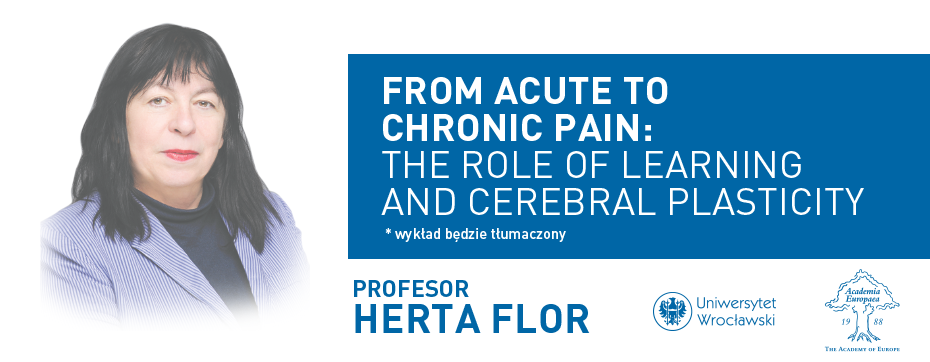Lecture by Prof. Herta Flor#
Academia Europaea Wrocław Knowledge Hub and Institute of Psychology, University of Wroclaw would like to invite for the lecture of Prof. Herta Flor, Member of Academia Europaea (Department of Cognitive and Clinical Neuroscience, Central Institute of Mental Health, Medical Faculty Mannheim, Heidelberg University).Date: 29 November, 2018; 17:00
Venue: Institute of Psychology, University of Wroclaw
Title: From Acute to Chronic Pain: the Role of Learning and Cerebral Plasticity
Professor Herta Flor – Scientific Director of the Cognitive and Clinical Neuroscience at the Central Institute of Mental Health in Mannheim and Professor of Neuropsychology at Heidelberg University. Recipient of many prestigious awards (including the Max-Planck Award for International Cooperation and the German Psychology Award) and member of leading academic and scientific institutions (such as Academia Europaea and the German Academy of Sciences Leopoldina). Research interests include: psychobiological aspects of treating chronic pain, neural correlates of learning and memory, treatment of anxiety, depression, substance abuse and personality disorders, and neuropsychological rehabilitation.
Selected publications:#
- Flor, H., Elbert, T., Knecht, S., Wienbruch, C., Pantev, C., Birbaumer, N., Larbig, W., & Taub, E. (1995). Phantom limb pain as a perceptual correlate of cortical reorganization. Nature, 357, 482-484.
- Birbaumer, N., Ghanayim, N., Hinterberger, T., Iversen, I., Kotchoubey, B., Kübler, A., Perelmouter, J., Taub, E., & Flor, H. (1999). A spelling device for the paralyzed. Nature, 398, 297-298.
- Flor, H., Nikolajsen, L., & Jensen, T. S. (2006). Phantom limb pain – a case of maladaptive central nervous system plasticity? Nature Reviews Neuroscience, 7, 873-881.
- Wessa, M., & Flor, H. (2007). Failure of extinction of fear responses in posttraumatic stress disorder: evidence from second-order conditioning. American Journal of Psychiatry, 164, 1684-1692.
- Flor, H., & Turk, D. C. (2011). Chronic pain. An integrated biobehavioral approach. Seattle, WA: IASP Press.
Abstract:#
The transition from acute to chronic pain is characterized by a shift from nociceptive brain circuits to those involved in emotion, motivation, and learning1. Maladaptive changes in these brain circuits can be induced by associative and non-associative mainly implicit learning processes such as sensitization, operant and respondent conditioning and priming. It is suggested that different concepts of chronicity may have a common psychobiological basis in maladaptive learning and plasticity processes2. Treatments should target these shifts in brain circuits and include both behavioral and pharmacological treatment options. Examples are exposure and extinction training, sensory discrimination training, mirror treatment, virtual reality applications, brain-computer interfaces as well as combinations of these treatments with pharmacological interventions.
References:#
1. Kuner, R., & Flor, H., (2017). Structural plasticity and reorganisation in chronic pain. Nature Reviews Neuroscience, 18, 20-30.
2. Flor, H. (2017). Pain has an element of blank – a biobehavioral approach to chronicity. Pain, 158, Suppl.1: S92-S96.


